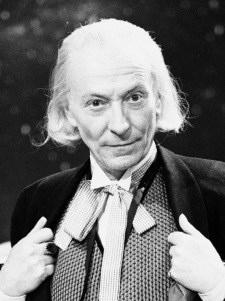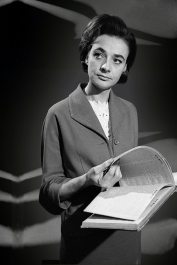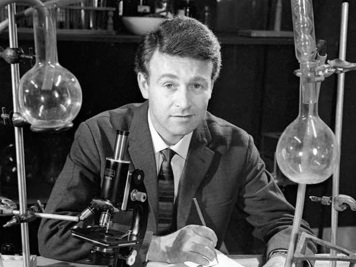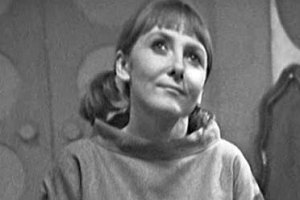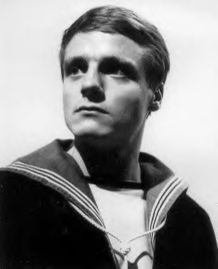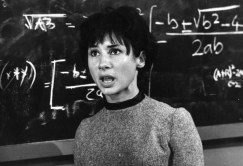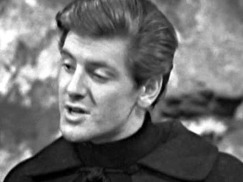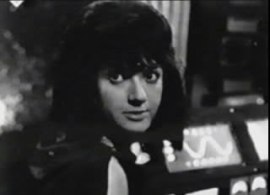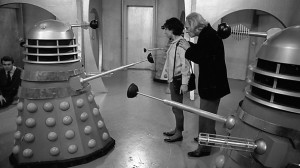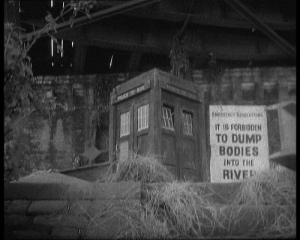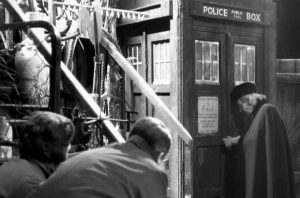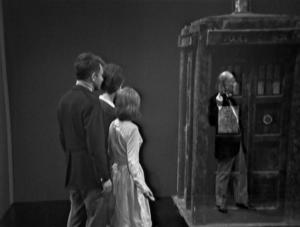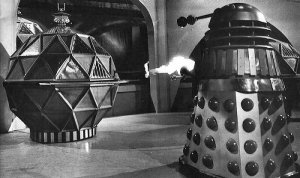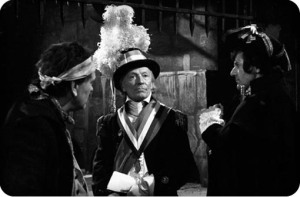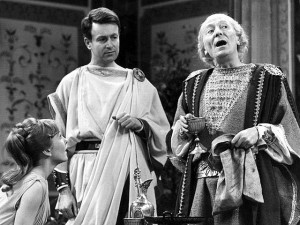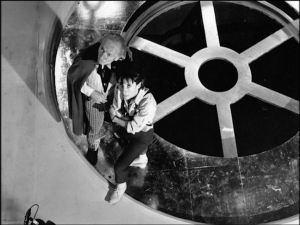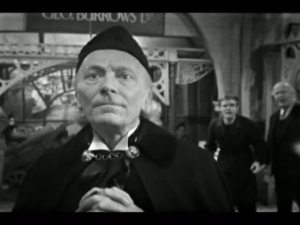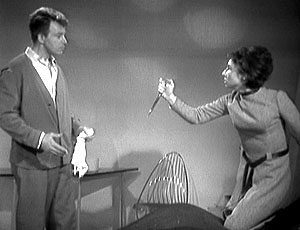William Hartnell was very different from how we view the Doctor today, and fans of the new series will find this seeming incongruity of the first incarnation of the Doctor difficult to adjust to.
Early on in the role, he was at times belligerent and arrogant, often contrary and even pompous in his attitudes. He had an early policy of non-interference, was not interested in having companions on his adventures (although he did have his granddaughter with him initially), and was a very prickly scientist , but over the years and after Susan left, he warmed up to Barbara and Ian, mellowed towards his companions and in the end of his run we loved the Doctor for the wise old sage that he was. Without his dynamic performance, Doctor Who would not have lasted for 50 years.
Best Companions: Barbara Wright / Ian Chesterton
————————————————————————————————————————————————
Honorable Mention: Vicki Pallister / Ben Jackson
——————————————————————————————————————————————————-
Worst Companions: Susan Foreman / Steven Taylor / Katarina
———————————————————————————————————————————————————————————————————–
BEST EPISODES (STORY ARCS)
NUMBER #1
The Daleks (#2)
Why it’s the best: The Doctor’s second story arc introduces arguably the most iconic monster in the Doctor Who universe, the Daleks, which are as famous (or possibly even more famous) than the show itself.
Sure the Dalek structure and design is not groundbreaking, but even in this early arc, their setting is very alien and their concept is terrifying. The writers did an excellent job of creating an elaborate backstory for the Daleks, and it was so compelling that the story has been developed and elaborated on repeatedly over the many years of the shows’ long run.
Not to mention, for the first time in the show’s early development, the characters are beginning to work and develop their camaraderie and strength as a team. This is THE arc of the original Doctor’s that every fan of the show should see.
————————————–
NUMBER #2
The Daleks Invasion of Earth (#10)
Why it’s the best: Some people might argue that while the first Daleks story arc is good, this is the first arc featuring the Daleks that was great. I won’t go that far, but I will say this one has a lot to offer.
Set in the future, Earth has been invaded by the Daleks and the human race is subjugated to them. An excellent arc overall, and the first time the Doctor made the conscious decision to fight the Daleks and perhaps alter the future. What really makes this a standout, though, is this is the arc where the Doctor says his first goodbye to a companion and it is one of the most poignant moments in the first Doctor’s history.
——————————————————————————————————————————–
NUMBER #3
An Unearthly Child (#1)
Why it’s the best: This is the very first story arc and includes the pilot of Doctor Who. It starts not with the Doctor, but with school teachers Barbara Wright and Ian Chesterton, and they become the viewer’s entrance into this strange world of the TARDIS and the Doctor. While the story itself is basic in its plot, it presented the structure of every episode that was to come after it, presenting this enigmatic figure of the Doctor who would lead his companions on every conceivable adventure through time and space.
A must see for every fan of the show.
————————————————————————————————————————————————-
NUMBER #4
The Space Museum (#15)
Why it’s the best: For my part, I prefer the arcs that show us the Doctor at his timey-whimy best. In the first Doctor’s arcs, no story did this quite as well as The Space Museum. While previous arcs had led the Doctor to new places in space and time, this arc was the first to show some of the more unusual problems with the very act of time travel. One of the most original of the first Doctor’s travels, this is one of the lesser mentioned but outstanding arcs from the first Doctor.
——————————————————————————————————————————–
NUMBER #5
The Chase (#16)
Why it’s the best: The Chase is either loved or hated by fans. I am one who loves it. It has its very silly moments, (but then so do many of the Doctor’s stories) but what makes this one of the best for me is the madcap chase by the Daleks of the Doctor and his companions through time and space. With some of the funniest plot twists of the first Doctor’s stories (and some of the greatest sound and visual effects), this is really a fantastic adventure.
What also makes the Chase among the very best arcs, is that it features the exit of two of the best companions in Who history, Barbara Wright and Ian Chesterton, the first Doctor’s best companions, and really gives their exit an emotional poignancy. This is a truly great arc.
—————————————————————————————————————————–
NUMBER #6
The Reign of Terror (#8)
Why it’s the best: The first few seasons of Doctor Who, unlike the later series, often featured story arcs that were purely historical without any science fiction elements mixed into the stories (besides the characters finding themselves in a time they didn’t belong). The characters would get involved with the events of that historical period and be challenged by it.
The best arc to feature the historical setting was The Reign of Terror. Some might argue that The Aztecs or Marco Polo were stronger stories, but none was as much fun and had as many twists for me as The Reign of Terror. Set during a period of hyper paranoia in France, during the French Revolution, when so many people were being killed and the power structure was changing quickly, the Doctor and his companions, being unknown strangers, quickly found themselves at a disadvantage. This was also the first arc where William Hartnell stepped up and took a leading role in the story as the hero. This is another truly excellent story arc.
* (Episodes 4 and 5 are missing, but have been reconstructed using animation on the DVD release.)
——————————————————————————————————————————-
NUMBER #7
The Romans (#12)
Why it’s the best: This was one of the earliest story arcs to use humor really effectively. Set in ancient Rome, this story has the Doctor separated from two of his companions, Barbara and Ian, and traveling to Rome with Vicky. This is another of the terrific early examples of a historical story arc that was lots of fun. For the first time we see a glimpse of the young man the Doctor hides in his frail exterior. This was the first great glimpse at the idea that there may be more to the Doctor than meets the eye.
——————————————————————————————————————————————
NUMBER #8
Planet of Giants (#9)
Why it’s the best: Another one of the early episodes to show the possible problems with travel through time and space, in this episode the Doctor and his companions get their spacial dimensions altered. Not at first understanding where they are, they quickly discover that they have been shrunk to a fractional size, and have to navigate the problems of a world that is unreasonably large in scope. Having some of the best effects and props of the early seasons, this was a precursor to “Honey, I Shrunk the Kids”, and while the plot is not brilliant, it is worth it for the fun of seeing the world on a different scale.
——————————————————————————————————————————————
NUMBER #9
The War Machines (#27)
Why it’s the best: Introducing two new companions to the Doctor, this is the first story arc that started exploring the dangers of a computer run world, and was a precursor for the crazy computers and computer-like monsters that followed. This arc also introduces another one of the dynamic duos in Doctor Who’s long run, Polly and Ben, and they really are a breath of fresh air after the Doctor’s previous two companions, Dodo and Steven. Here Polly and Ben work with the Doctor, and for the first time, the Doctor has become the solid leading man in the story with his companions merely along for the adventure. It solidified the dynamic that would continue for the rest of the series.
——————————————————————————————————————————————
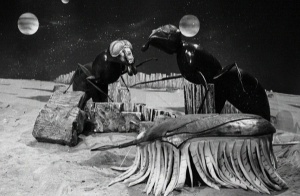
NUMBER #10
The Web Planet (#13)
Why it’s the best: This story arc has one of the most elaborate and foreign sets of the early Doctor Who seasons, one of the more fantastical stories in early Who history, it presents a world inhabited by strange insect-like creatures. Insect-like aliens would reoccur in later Doctor Who arcs, (although not these exact creatures), but none ever seemed so strange as these, and some of the final scenes of the arc stand out as among the most creepy scenes of the series.
——————————————————————————————————————————————
WORST EPISODE (STORY ARC)
The Edge of Destruction (#3)
Why it’s the worst: The Edge of the Destruction was one of the shortest story arcs of the first Doctor’s run, and one of the earliest. However, other arcs (Planet of the Giants, Mission to the Unknown) were as short or shorter, and were still far better stories. The problem with the arc is not its length, but its content. By focusing on the four main characters of the show, trapped in the TARDIS together and blaming each other for the problems they are encountering, it has the characters going from one extreme of emotion to another with no explicable reason. It seems possible that since it was so early in the series the writers and actors really did not have a solid idea of who the characters were yet, and this was a way of testing that out, but it did not work. It just ends up being confusing and strange.
